February 15, 2023
 by Jocelyn Stange / February 15, 2023
by Jocelyn Stange / February 15, 2023

Business growth relies on activity.
But without employees committed to growth, you can't establish positive activity levels. Employees are the primary force in determining the quality of a workplace and an organization's future.
In today's competitive marketplace, employee engagement has become a crucial driver of business success. It's an increasingly popular topic among HR and C-level leaders.
Employee engagement is the connection employees feel with their place of work. High levels of engagement will boost talent retention, promote loyalty and enhance business performance. Ultimately, it’s about translating perceptions into numbers, numbers into insights, and insights into actionable intelligence.
Organizations use employee engagement software to get feedback and draw actionable insights that promote employee success across the board. They recognize the value of implementing effective employee engagement strategies to invest in human capital and get a high return on investment (ROI) for the business.
There are many kinds of employee engagement models that measure different aspects of engagement in a company. These aspects mainly focus on the following three areas:
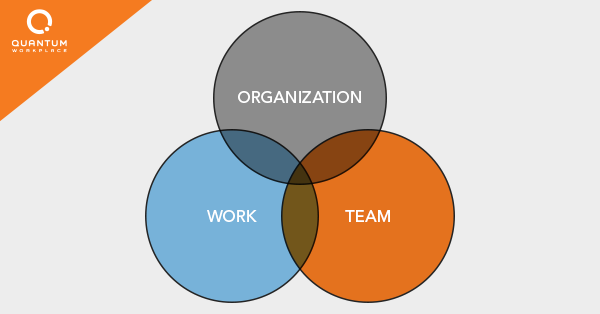
When employees are engaged at each level, the organization will have a more dynamic and successful workflow. For instance, an example of an employee engagement model would include measuring the outcome and engagement drivers associated with each of these levels.
Engagement outcome helps in revealing the current state of engagement:
Engagement drivers are actionable survey questions that help organizations maintain, improve, or drive engagement outcomes:
When employees are engaged, organizations are more successful. When they are disengaged, organizations suffer. Engaged employees work harder, stay longer, take more initiative, and motivate others to do the same.
A study conducted by Gallup showed that engaged employees produce better business outcomes, including:
This is true across industries, company sizes, and locations, and in good and bad economic times.
Based on commitment and dedication, employee engagement is classified into three levels:
Many components that drive a workplace can influence employee engagement directly. So, a decline in engagement levels can result from any number of such factors and their respective combinations.
The easiest way to demotivate a workforce is by ignoring their well-being and not considering mental health factors like stress, anxiety, and job burnout. Failure to address these issues will result in employee disengagement.
Financial stress is one of the most common aspects of employees feeling disconnected from their workplace. Employees will feel no motivation to be involved or work with interest if they don't get compensated adequately.
An employee’s decision to stay with an organization depends heavily on growth opportunities. So, providing the necessary employee training and learning opportunities is crucial to keep employees engaged and committed to their jobs.
Not acknowledging employees for their hard work and achievements can instantly harm their morale and motivation levels. Moreover, impersonal rewards and recognition systems will decline employee engagement even further.
of US employees are actively engaged in their workplace, marking a 4% decline since 2020.
Source: Gallup
When it comes to engaging employees, there’s too much at stake to throw spaghetti at the wall and hope it sticks. Explore these strategies to approach employee engagement the right way.
Employee engagement surveys are a great way to collect and understand employee feedback. But to paint a clear picture of engagement throughout your organization, you need more. Recognizing achievements through employee rewards and recognition programs can play a big role in boosting engagement, showing employees that their contributions are valued and appreciated.
Employee feedback shouldn’t be a once-yearly initiative. Instead, it should be woven into the fabric of your organization. Build a robust feedback culture with a continuous listening strategy that includes the following:
Employee engagement is a perception and science. You should measure, track, and analyze it over time. But how do you know if your employee engagement survey is measuring engagement?
Be careful with DIY surveys. They might be cheap or easy, but collecting feedback differs from measuring engagement. You need a good and trusted tool for that. Preferably one that an employee engagement expert develops.
Defining communication channels is critical to any initiative's success. Be clear about the purpose of your engagement efforts and set expectations for employees upfront.
Make sure leaders, managers, and employees all understand the what, when, why, and how of what’s happening. Communicate with your employees often. It’s always safe to assume that you could be more transparent, proactive, and frequent in your communication.
Following your survey, employees will want to know what’s next. Share your survey results and follow-up plans with leaders, managers, and employees. This builds confidence in the employee engagement survey itself and your organization’s leadership.
Employee engagement isn't just HR's responsibility. Senior leaders, HR teams, managers, and employees are essential in moving the needle.
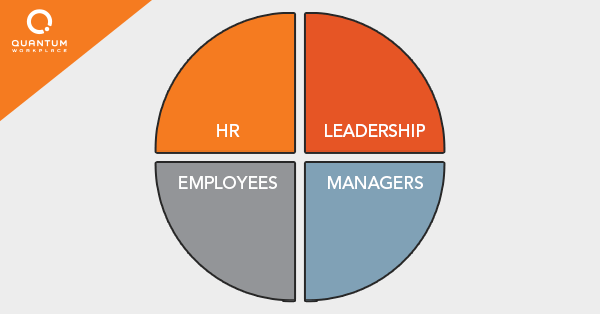
Everyone should be held accountable for the success of engagement efforts. Employees at all levels can make an impact on engagement through
Employee engagement is more than sending out surveys. Many organizational decisions, processes, and relationships impact engagement and performance, including the following:
To make the most of your engagement data, tie it to key business metrics. This will paint a clear picture of how your people strategies support business success. It will also help you justify current and future investments and initiatives.
Simon Sinek
Author and Founder, The Optimism Company
There are a lot of fun ways to engage your employees. But some ideas will have a more significant impact than others. Try out these employee engagement ideas in your organization.
A lot happens in your organization between annual engagement surveys. Follow up on engagement survey results with lightweight pulse surveys. These surveys can help you dig deeper into specific issues that come up. You can even target different groups on the unique topics that matter to them.
Collecting specific, real-time employee feedback can help you make quick and smart decisions. But frequent requests can be annoying – especially when no action is taken. Be respectful of your employees’ time by choosing questions that capture actionable data. And be sure to follow up on the results!
The quickest way to see improved employee engagement is by asking your employees. Yes, it's that simple sometimes. Generate ideas and strategies by conducting an employee focus group. Focus groups can help you compile diverse thoughts and perspectives at once and authentically boost action plans.
These employees are your biggest lever for impact. Their middle-of-the-road opinions are often the easiest to influence. Boost confidence in your neutral or favorable employees to create strong internal advocates. They can motivate less engaged coworkers and champion employee engagement within your organization.
Presenting organization-wide results is essential. But to impact change at the local level, you need to empower your managers to drive engagement. Equip your people leaders to review, analyze, and discuss results within their teams. Coach them to follow up with employees and continue the feedback loop with their teams.
Employee engagement and performance are inextricably linked. Successful employees are more engaged – and engaged employees are more successful.
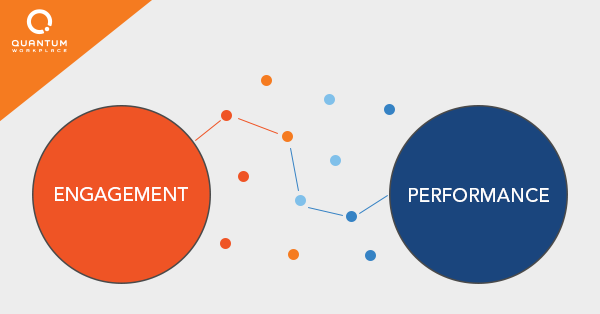
This means your performance management approach has a huge impact on engagement. Shift toward a modern strategy that encourages ongoing feedback, coaching, recognition, and development.
Employee recognition and development are key drivers of engagement across almost all organizations and industries. Bottom line: employees who feel valued and appreciated will go the extra mile. But they also want to pick up a few skills and experiences along the way.
Investing in software is a big decision. If you’re not sure if you’re ready to make an investment, consider these benefits of employee engagement software:
Lean on employee engagement software (and the team that comes with it) to do the heavy lifting. You’ll benefit from proven methods, templates, resources, training, expert coaching, and more. This frees up more time and energy for you to focus on what matters.
Employees are complex. And the path to employee and business success isn’t always crystal clear. Engagement software can help you gather critical employee data and intelligence. You’ll have access to insights that help you make smarter business decisions.
Building trust takes time, but it's a vital part of your engagement strategy. Employee engagement software helps you facilitate ongoing conversations with employees. These conversations help show that you care about their opinions, their experiences, and their future.
The employee experience is constantly changing, so you need to act fast on employee feedback. Engagement software can help you do just that. Survey dashboards display your organization's unique drivers of engagement. Analytics tools slice and dice your data so you can take immediate action with targeted strategies.
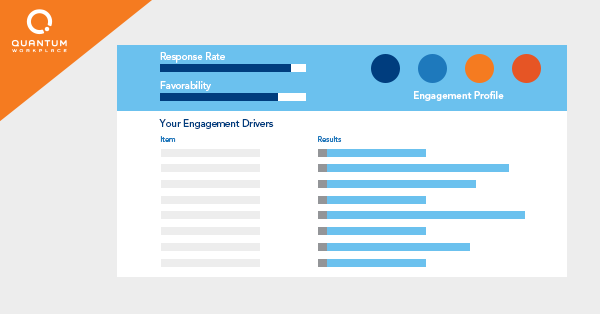
Engagement software catches opportunities and issues sooner so you can be proactive about engaging and retaining your workforce.
As stated above, engagement and performance are inextricably linked. That being said, your employee engagement software should do much more than help you survey your employees.
With the right set of tools, you can boost work performance and success across the board. Software that helps you connect the dots between your engagement and performance data will take your organization to new heights.
Your engagement survey shouldn’t be the only initiative you use to understand and drive employee engagement. Find software that helps listen to and support employees all year round. Your software should help you:
Your employee listening strategy should be continuous. You should be capturing a variety of employee voices in a variety of ways. Find software that allows you to collect, act on, and respond to employee feedback with engagement, pulse, and lifecycle surveys.
Acknowledging your employees for their contributions can drive engagement and performance. Share their success by selecting a vendor that provides an online recognition tool.
Employees need clarity and purpose to be fully engaged and successful. Your employee engagement software should help teams set, track, and discuss goals. It should showcase and encourage alignment among individual, team, and organizational goals.
Ongoing feedback is essential to engagement and performance. Employees need to understand their strengths and blind spots. Select software that can help your managers and employees give and receive feedback regularly and easily.
Employees need to feel supported by and connected to their manager and organization. Regular communication is necessary for your employees to feel connected and engaged. Foster stronger manager-employee relationships and continuous performance conversations with a 1-on-1 tool.
Talent development has become a top priority for organizations. But to understand how to retain and develop top talent, organizations need data. A robust engagement software should also offer a talent review tool to improve retention and reduce turnover.
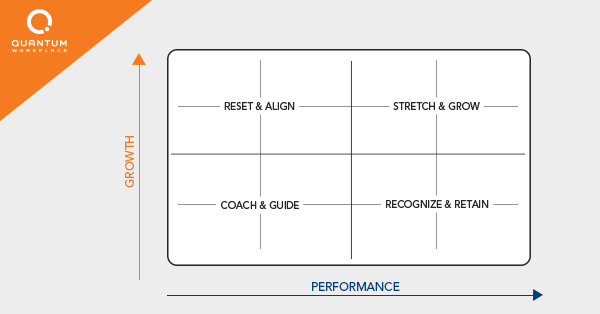
Managers are on the front lines of engagement. They need a lot of coaching and development to help their employees. Equip your managers with the tools they need to understand their team's needs and do the work at the ground level.
Avoid vendors who create barriers to accessing your employee data. It should be easy to measure the engagement for analyzing and improving it. Your software provider should provide quick and instant access to your employee data and surface insights in pre-built or customizable reports.
Making meaningful progress in your employee engagement initiatives can be challenging. While recognizing the importance of engagement is critical, where do you go from there? Successful organizations learn to listen, focus, and transform.
Leverage these employee engagement best practices to take your efforts to the next level.
Employees who feel their hard work is not acknowledged will not work to their maximum potential. Providing recognition and rewarding good work with special employee benefits and incentives is an excellent way to motivate employees.
Many companies offer awards and certificates, while others provide monetary incentives or gift vouchers. Your rewards policy should align with your corporate culture and company policies to steer your people in the right direction.
If you want to understand what engages or disengages your employees, you need to ask them. If you don’t, you won’t be successful in delivering the experience they expect.
Leaders and managers should prioritize continuous feedback. This allows organizations to understand and respond to needs and issues as they come up. Asking for feedback shows employees that you care and are willing to listen and take action.
Collecting employee feedback is a significant first step. But the most effective employee engagement programs emphasize follow-ups. Research shows that employees whose managers follow up after a survey are 12x more likely to be engaged the following year than those without follow-up.
In other words, feedback is only as valuable as the action it inspires. Gather information, share it with your people leaders, and encourage them to take action on the things that matter most.
Employee engagement doesn’t have to be a shot in the dark. When you understand what drives engagement in your organization, you can create targeted and impactful strategies. You must track, analyze, and adjust as you gather more information and make changes.
The days of the annual engagement survey are gone, and a new era of engagement is upon us. Now, businesses move too quickly to only study engagement once a year! Find ways to keep engagement at the forefront all year long. You can continuously listen, respond, and put your employees first.
Successful organizations know that their people are an essential company resource. Employee engagement has evolved from an annual survey to a robust and vital business strategy.
To begin improving employee engagement, you must commit to real change. You must measure and understand what engagement looks like in your organization. And then put the tools and processes in place to drive engagement and high performance.
Start by implementing employee recognition software in your company to acknowledge employee success and milestones.
This article was originally published in 2020. It has been updated with new information.
Jocelyn Stange is a writer and editor with over 5 years of experience. She works with subject matter experts to write content that helps buyers make informed product decisions. When she's not creating new resources, she enjoys dancing, golfing, and playing with her Goldendoodle, Murray.
People tend to wait until their exit interview to reveal what they really think and why...
 by Elizabeth Klinetobe
by Elizabeth Klinetobe
Imagine a high-performing team so engaged and loyal that turnover becomes a distant memory.
 by Andrej Kovačević
by Andrej Kovačević
When managers meet with their employees more, they get a better picture of their experience at...
 by Jocelyn Stange
by Jocelyn Stange
People tend to wait until their exit interview to reveal what they really think and why...
 by Elizabeth Klinetobe
by Elizabeth Klinetobe
Imagine a high-performing team so engaged and loyal that turnover becomes a distant memory.
 by Andrej Kovačević
by Andrej Kovačević


